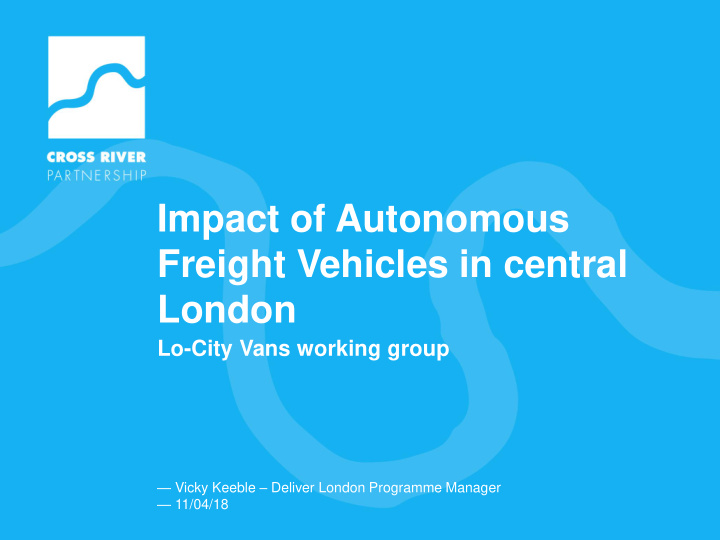



Impact of Autonomous Freight Vehicles in central London Lo-City Vans working group — Vicky Keeble – Deliver London Programme Manager — 11/04/18
Who is Cross River Partnership? | Delivering London’s Future Together | Annual Report and Business Plan 2016/17/18 1
Operating across central London | Delivering London’s Future Together | Annual Report and Business Plan 2016/17/18 2
CLSRTP: Purpose of Study ▪ To analyse what the impact autonomous vehicles (AVs) for deliveries and servicing will have on wider transport and public space in central London ▪ To uncover the physical , technical and governance based interventions boroughs should consider in the lead to AV Freight AV Freight: ▪ Fully autonomous vehicles have the capacity to perform all driving functions without human supervision | <Highlight here and type the name of the presentation | <Highlight here and type name of the client> 3
AV Freight Vehicles Driverless vans Ground Drones • Pavement mounted robots for • Van-like vehicles with multiple storage small deliveries compartments • Suitable for last-mile deliveries • Travel on the road • Shares pedestrian and cycle • 60 mile electric range space • Cloud based technology shared between vehicle, customers and merchants | <Highlight here and type the name of the presentation | <Highlight here and type name of the client> 4
Current infrastructure requirements • AV use may free up space currently used for parking, loading and garages allowing more efficient use of land space. • This space efficiency will not be yielded until there is significant uptake of AV technologies • There will be a transitional period where spaces of shared use may become more contested | <Highlight here and type the name of the presentation | <Highlight here and type name of the client> 5
Benefits of AV Freight Benefits for consumers Benefits for businesses • Optimised delivery services • Meet the demands of rising online consumerism • Finds the quickest route in real-time • Same-day responsive deliveries • Drives for long periods without rest • Decreased operational costs passed to • Ease congestion in built up areas the customer • No need to pay a driver • Road safety improvement • Safer without human occupant • Fuel cost saving | <Highlight here and type the name of the presentation | <Highlight here and type name of the client> 6
Barriers and Enablers of implementing AV Freight BARRIERS ENABLERS • Technology must be proven • Robust safety features • Technology must be affordable • Positive media coverage • Accountability must be clear • Government provisions • Cybersecurity is a risk • Test beds | <Highlight here and type the name of the presentation | <Highlight here and type name of the client> 7
Recommendations 1. Government investment is required in the development and testing of new technologies, specifically freight and logistics 2. TfL funding needs to support logistics operators with the uptake of AV freight 3. AV freight trials must focus on determining what infrastructure is necessary ahead of deployment 4. Public perceptions of AV freight should be influenced by positive media coverage 5. Policy and regulation must be in place before AV technology is deployed | <Highlight here and type the name of the presentation | <Highlight here and type name of the client> 8
Recommendations • Government investment is required in the development and testing of new technologies, specifically freight and logistics 1 • Government funding and initiatives such as Innovate UK • Use funding to develop test beds • Exploit existing test beds • Ensure the technology is robust | <Highlight here and type the name of the presentation | <Highlight here and type name of the client> 9
Recommendations • TfL funding needs to support logistics operators with the uptake of AV freight • Customer demand for AV freight would spur development 2 • Logistics operators wary of investing in uncertain technologies • Financial incentive for operators to invest would increase uptake and reduce risk • OEMs must lobby central government for funding | <Highlight here and type the name of the presentation | <Highlight here and type name of the client> 10
Recommendations • AV freight trials must focus on determining what infrastructure is necessary ahead of deployment • We do not yet know what infrastructure is necessary • 3 Communications infrastructure may need to be expanded beyond 4G networks • Localised trials will help establish what infrastructure is required in each area • Infrastructure requirements should be focused on while trials are being undertaken | <Highlight here and type the name of the presentation | <Highlight here and type name of the client> 11
Recommendations • Public perceptions of AV freight should be influenced by positive media coverage • Negative media coverage could seriously impede uptake of AV freight • It is the responsibility of developers, 4 insurers and government to manage public perceptions and overcome misconceptions • Public visibility in to trials, forums and workshops could help to shape public perception • Successful trials should be given media coverage | <Highlight here and type the name of the presentation | <Highlight here and type name of the client> 12
Recommendations • Policy and regulation must be in place before AV technology is deployed • OEMs need to use policy as a guideline for what functionality AV freight must have • There is apprehension to develop policy 5 before the full extent of the technology is known- this could result in a standstill • Policy makers must take the lead by outlining principles they wish to achieve • Policy and regulation must be developed with input from all stakeholder groups | <Highlight here and type the name of the presentation | <Highlight here and type name of the client> 13
Thank you. QUESTIONS? Vicky Keeble Deliver London Programme Manager T: 020 7641 2036 E: vickykeeble@crossriverpartnership.org | <Highlight here and type the name of the presentation | <Highlight here and type name of the client> 14
Recommend
More recommend